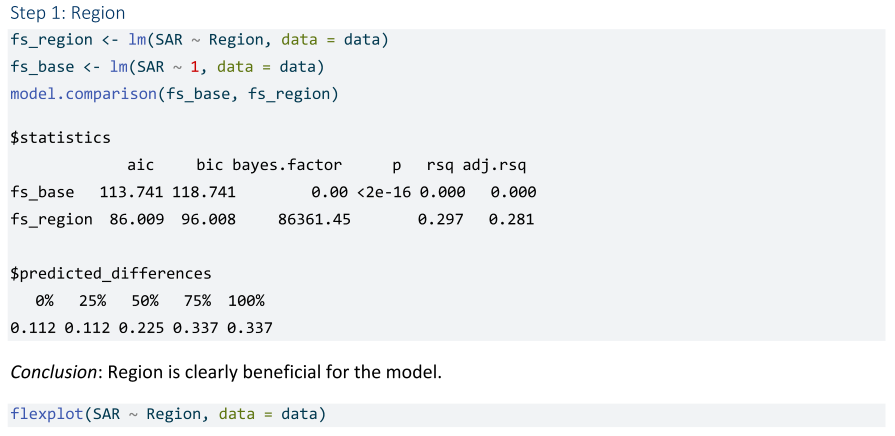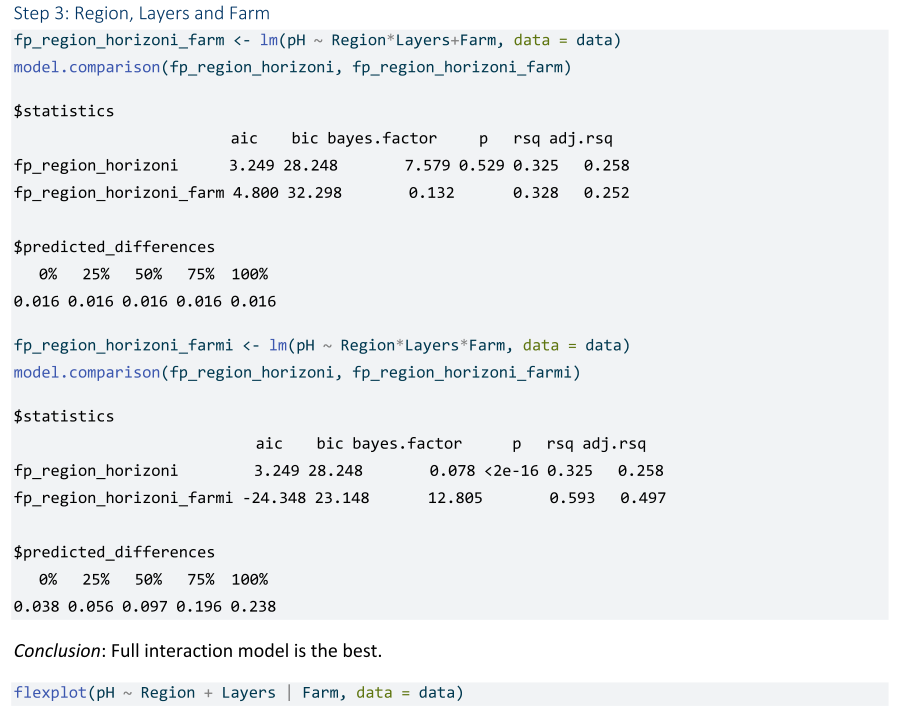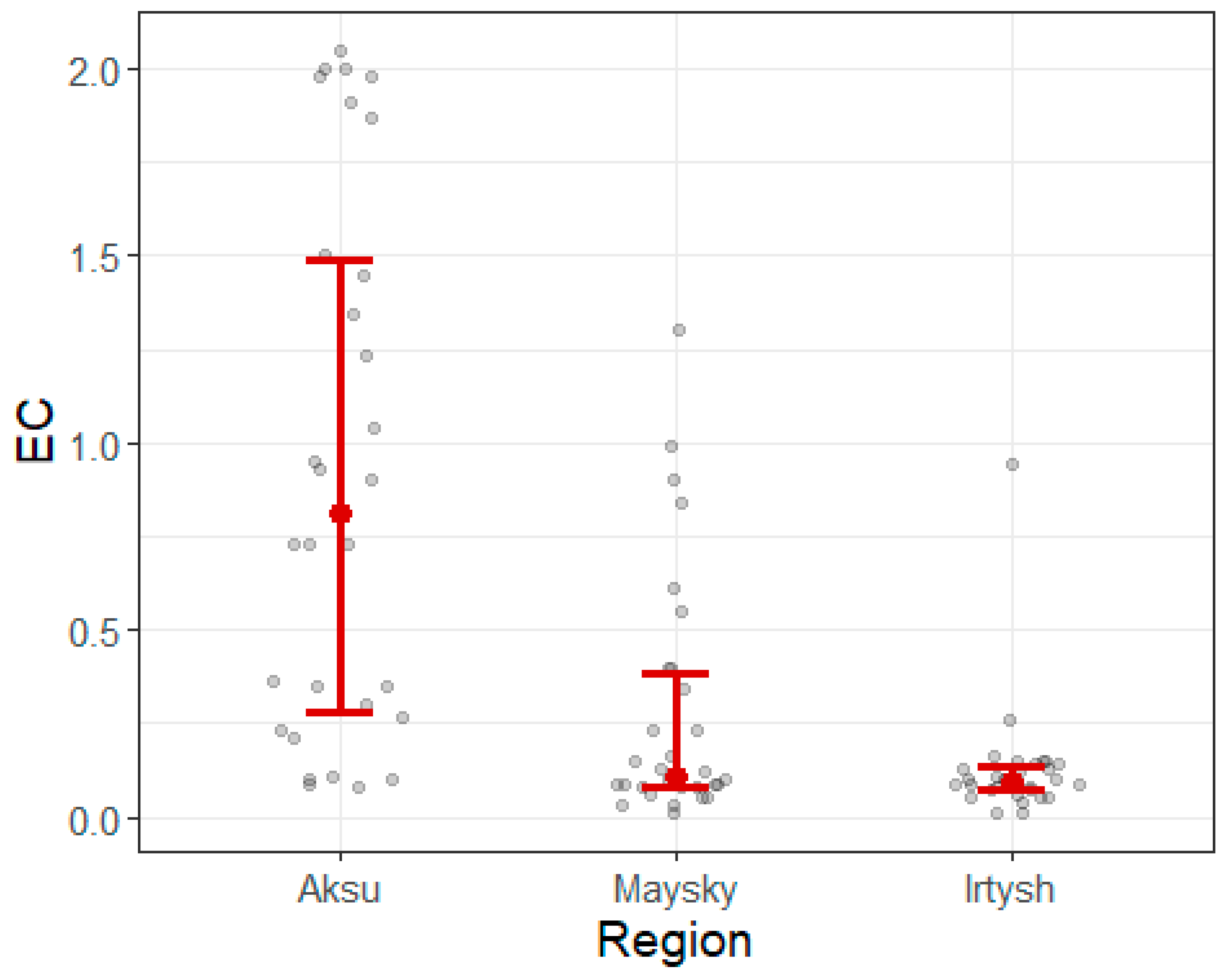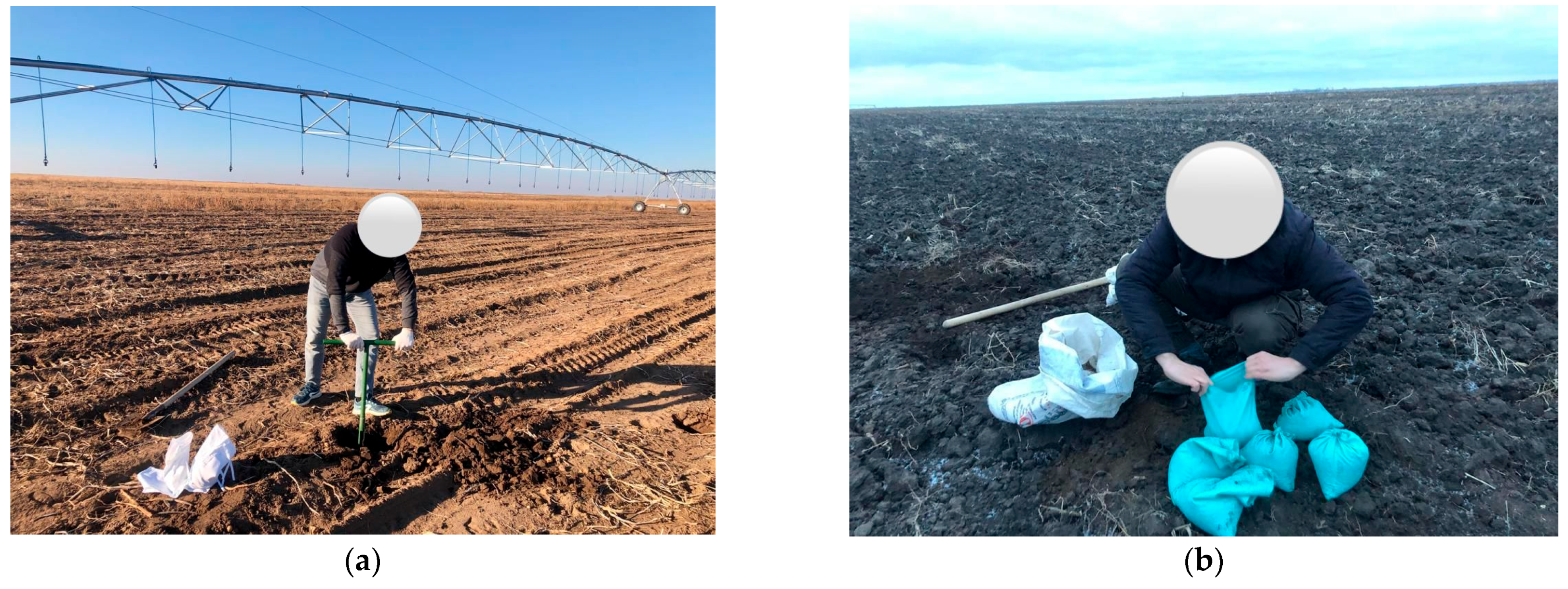A key finding of this study was the marked contrast in soil conditions across the investigated locations, particularly concerning the impact of irrigation. As presented in the Results Section (
Section 3.1), the irrigated Haplic Kastanozems in the Aksu district showed degradation in the topsoil (0–20 cm), characterized by high exchangeable sodium percentage (ESP) values (ranging from 18.04 to 23.63) and elevated electrical conductivity (EC) (typically exceeding 2 dS/m). This development of saline characteristics in Aksu, particularly when compared to the generally unaffected non-irrigated soils or soils in other districts [
5,
39], aligns with findings in other irrigated arid regions where high ESP and/or EC characterize problematic salt-affected soils [
35]. An interesting aspect that is also highlighted in the Results Section for Aksu was that despite the high ESP, the corresponding sodium adsorption ratio (SAR) remained low (
Table 1). This suggests that sodium accumulation predominantly affects the exchange complex rather than the soil solution at the time of sampling in these soils.
Explaining the Contrasting Effects of Irrigation on Soil Salinity Across Districts
The divergent response of soil salinity to long-term irrigation across the studied districts is a central finding. While irrigation generally led to lower EC values in the Irtysh and Maysky districts compared to their non-irrigated counterparts (indicating a net leaching effect, as shown in
Figure 7A and presented in
Section 3.1), a secondary salinization (EC > 2 dS/m, ESP > 15%) was observed in the irrigated Haplic Kastanozems of the Aksu district. We hypothesize that these contrasting outcomes are driven by a complex interplay of regional agro-climatic conditions, inherent soil properties, local hydrogeological settings, and potentially differences in historical irrigation management.
In the Irtysh district, dominated by Haplic Chernozems and a more humid climate with higher annual precipitation (287.1 mm,
Section 3.2), irrigation likely enhanced natural leaching processes. The regular water supply under irrigation, combined with the potentially deeper groundwater levels and better natural drainage typical for Chernozemic landscapes in less arid conditions, would facilitate effective removal of salts from the root zone, leading to the observed lower EC values on irrigated plots.
In the Maysky district, despite its generally drier conditions compared to Irtysh and the presence of light chestnut soils (Haplic Kastanozems), irrigated plots also exhibited lower EC than non-irrigated ones. This suggests that on the studied sites, irrigation water application was managed in a way that promoted leaching or that the initial salinity of soils and groundwater was not critically high. The data also indicated that precipitation during the hot pre-vegetation period was higher in Maysky than in Aksu (
Section 3.2), which might have contributed to a more favorable initial salt balance before the peak irrigation season. It is also possible that groundwater levels in the specific Maysky study plots were deeper or less saline than those encountered in Aksu.
Conversely, the pronounced degradation in the Aksu district (irrigated Haplic Kastanozems) points towards secondary salinization processes intensified by irrigation. This outcome is attributed to a synergistic combination of local agro-climatic, soil, and hydrogeological factors, exacerbated by irrigation inputs. In Aksu, these combined factors appear to have created a scenario where capillary rise and salt accumulation from shallow groundwater overwhelmed any leaching effects of irrigation.
The study design, involving paired comparisons of irrigated and non-irrigated plots on dominant soil types within each distinct agro-climatic district, was chosen to assess the specific impact of irrigation under these varied local conditions. The contrasting results obtained are therefore considered a significant finding, highlighting the site-specific nature of salinization processes and cautioning against generalizing the effects of irrigation without considering the local environmental context.
This pronounced degradation in Aksu, particularly evident when compared to other sites, can be attributed to a synergistic interplay of several local factors:
Climate: The Aksu district experiences higher temperatures and lower precipitation compared to Irtysh, leading to significantly higher potential evapotranspiration rates. Irrigation adds the necessary moisture, which then evaporates intensely from the soil surface, concentrating salts and sodium previously present in the soil solution or brought up via capillary rise [
2,
20];
Irrigation and Groundwater Dynamics: Intensive irrigation, likely via center pivots in this area, can easily lead to the rise of already shallow groundwater tables, especially if natural or artificial drainage is suboptimal. Indeed, historical surveys indicate that groundwater depths in the Aksu (formerly Yermak) district often do not exceed 1.8 m [
19]. Irrigation likely further elevates these shallow levels, bringing potentially saline groundwater (which may originate from regional saline parent materials, as previously noted) closer to the surface and feeding the evaporative concentration process [
40,
41];
Soil Properties: Chestnut soils (Kastanozems), particularly the sodic variants common in the area, might be inherently more susceptible to structural degradation under irrigation compared to Chernozems. Dispersion of clay particles due to sodium can impede water infiltration and internal drainage, further exacerbating waterlogging and surface salinization [
23];
Local Site Conditions (Hypothetical): While not measured in this study, specific local factors on the sampled irrigated plot could also play a role. These might include suboptimal local drainage conditions, a longer history of intensive irrigation, or potentially higher salinity in the irrigation water used at this specific site compared to others [
19,
40].
The soil degradation identified mainly in the irrigated Aksu district, characterized by high EC and ESP values in the topsoil, necessitates the implementation of effective mitigation and management strategies. Based on established practices for saline soil reclamation and prevention of secondary salinization, several approaches appear relevant for the Pavlodar region. Optimizing irrigation water management is paramount. As highlighted by Karimzadeh et al. [
35], adopting water-efficient techniques like drip or improved furrow irrigation can minimize excessive water application, reducing deep percolation and the potential for water table rise—a likely contributor to the problems observed in Aksu. Complementary to efficient irrigation is the need for adequate field drainage to control water table depth and facilitate the removal of excess salts. While preventive leaching during the off-season can also aid in salt balance [
42], its effectiveness is contingent upon sufficient water availability and functional drainage. Given the sodicity indicated by high ESP in Aksu topsoils, chemical amelioration using calcium-containing amendments like gypsum might be considered to improve soil structure by replacing excess exchangeable sodium [
43], although the low SAR values suggest the soil solution itself may not be the primary driver of sodicity at present. Additionally, selecting salt- and sodicity-tolerant crops provides a crucial adaptive strategy for maintaining productivity in affected areas. Ultimately, a sustainable solution requires an integrated approach combining improved engineering (irrigation and drainage) with appropriate agronomic practices and informed decision making by land users.
The critical role of groundwater dynamics in soil salinization, particularly in arid and semi-arid regions like Kazakhstan, is well established. According to a study by Issanova et al. [
44], salinization is indeed more common in these arid regions. A primary mechanism involves the accumulation of salinity as groundwater rises towards the earth’s surface due to evaporation; this process is exacerbated if the groundwater outflow rate is less than recharge, leading to a rising water table [
45]. While this study did not include direct measurements of groundwater depth and quality, which constitutes a limitation, the observed patterns of salt accumulation, particularly the pronounced surface salinization in the irrigated chestnut soils of the Aksu district, strongly suggest the significant role of shallow groundwater dynamics in the region. High evaporation rates, characteristic of the local climate, likely promote capillary rise from the water table, transporting dissolved salts to the upper soil layer, especially when irrigation practices lead to elevated groundwater levels. The potential severity of this issue, should the groundwater indeed be shallow and saline, is highlighted by existing research. It is known that saline groundwater exacerbates soil salinity, reducing agricultural productivity [
46]. Furthermore, studies confirm that salinity risk can often result from highly saline groundwater, particularly when combined with a lack of drainage and associated salinity or alkalinity problems [
41]. Specifically, when extremely saline groundwater remains close to the root zone for extended periods without effective drainage, salt accumulation can severely damage root development and lead to significant reductions in crop production [
46]. The known prevalence of saline parent materials in parts of the Pavlodar region further underscores the potential risk of elevated groundwater salinity contributing to the observed soil conditions in the study area [
19]. Therefore, understanding the local groundwater regime (depth, seasonal fluctuations, and salinity) appears crucial for developing effective strategies to prevent and mitigate secondary salinization in the Pavlodar region. Knowledge of groundwater conditions is essential for selecting appropriate irrigation methods (e.g., favoring drip irrigation where water tables are high to minimize deep percolation and rise) and designing adequate drainage systems. Further research explicitly incorporating groundwater monitoring is highly recommended to confirm the role of groundwater dynamics and salinity and to refine site-specific management recommendations for sustainable agriculture in the region.
The lack of systematic surveys and scientific publications on water resources in the Pavlodar region pose serious challenges to the region’s agricultural sector. Farmers often lack access to up-to-date data on the state of water resources, making it difficult to plan and make informed decisions on farming. Without accurate information, it is impossible to develop effective recommendations on water use, which is especially important in the context of a changing climate and the risk of drought.







































